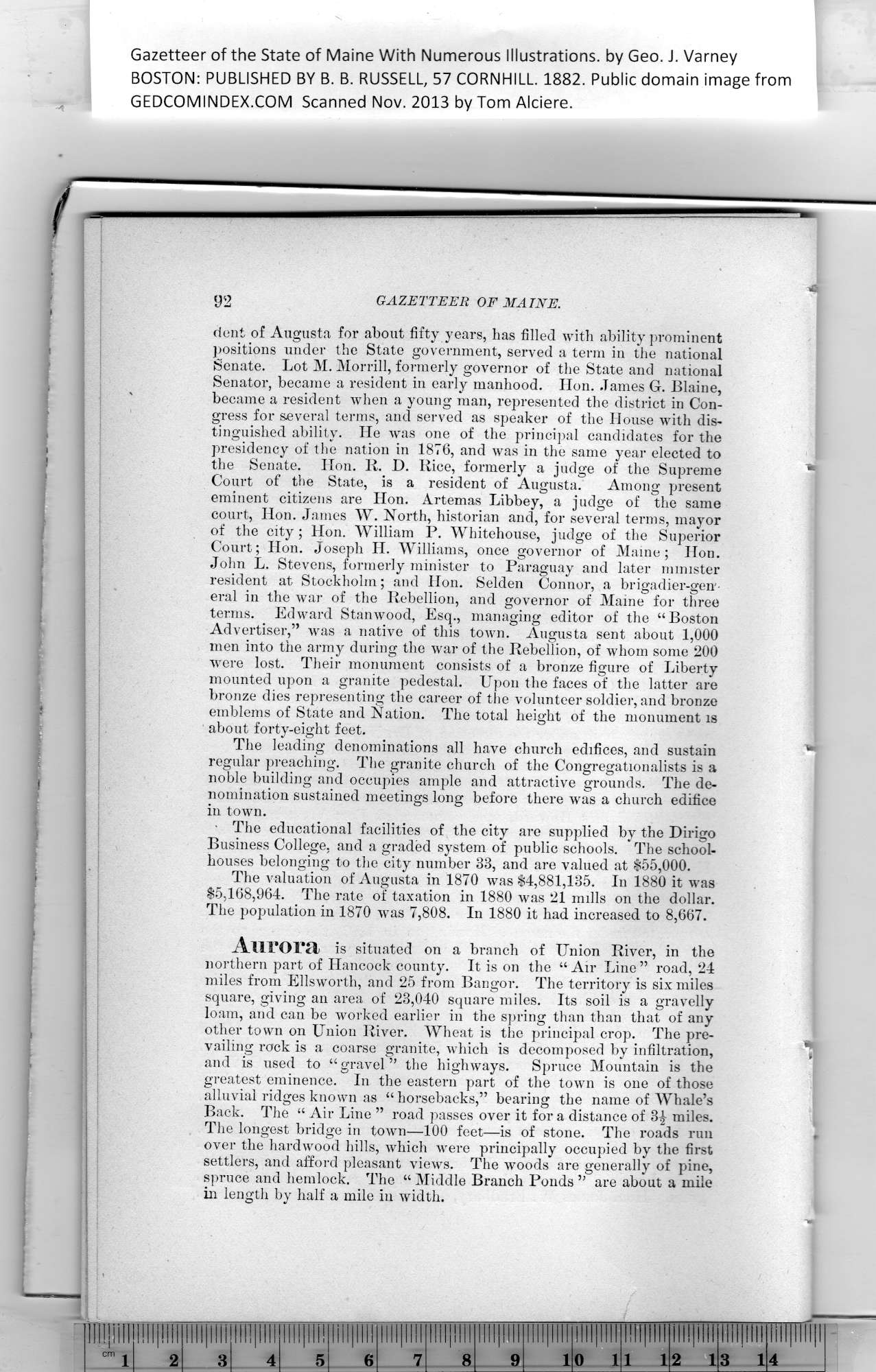|
Gazetteer of the State of Maine With Numerous Illustrations, by Geo. J. Varney
BOSTON: PUBLISHED BY B. B. RUSSELL, 57 CORNHILL. 1882. Public domain image from
92 GAZETTEER OF MAINE.
dent of Augusta for about fifty years, has filled with ability prominent
positions under the State government, served a term in the national
Senate. Lot M. Morrill, formerly governor of the State and national
Senator, became a resident in early manhood. Hon. James G. Blaine,
became a resident when a young man, represented the district in Con-
gress for several terms, and served as speaker of the House with dis-
tinguished ability. He was one of the principal candidates for the
presidency of the nation in 1876, and was in the same year elected to
the Senate. Hon. R. D. Rice, formerly a judge of the Supreme
Court of the State, is a resident of Augusta. Among present
eminent citizens are Hon. Artemas Libbey, a judge of the same
court, Hon. James W. North, historian and, for several terms, mayor
of the city; Hon. William P. Whitehouse, judge of the Superior
Court; Hon. Joseph H. Williams, once governor of Maine; Hon.
John L. Stevens, formerly minister to Paraguay and later minister
resident at Stockholm; and Hon. Selden Connor, a brigadier-gen-
eral in the war of the Rebellion, and governor of Maine for three
terms. Edward Stanwood, Esq., managing editor of the “Boston
Advertiser,” wras a native of this town. Augusta sent about 1,000
men into the army during the war of the Rebellion, of whom some 200
were lost. Their monument consists of a bronze figure of Liberty
mounted upon a granite pedestal. Upon the faces of the latter are
bronze dies representing tbe career of the volunteer soldier, and bronze
emblems of State and Nation. The total height of the monument is
about forty-eight feet.
The leading denominations all have church edifices, and sustain
regular preaching. The granite church of the Congregationalists is a
noble building and occupies ample and attractive grounds. The de-
nomination sustained meetings long before there was a church edifice
in town.
• The educational facilities of the city are supplied by the Dirigo
Business College, and a graded system of public schools. The school-
houses belonging to the city number 38, and are valued at $55,000.
The valuation of Augusta in 1870 was $4,881,135. In 1880 it was
$5,168,964. The rate of taxation in 1880 was 21 mills on the dollar.
The population in 1870 was 7,808. In 1880 it had increased to 8,667.
Aurora is situated on a branch of Union River, in the
northern part of Hancock county. It is on the “ Air Line ” road, 24
miles from Ellsworth, and 25 from Bangor. The territory is six miles
square, giving an area of 23,040 square miles. Its soil is a gravelly
loam, and can be worked earlier in the spring than than that of any
other town on Union River. Wheat is tire principal crop. The pre-
vailing rock is a coarse granite, which is decomposed by infiltration,
and is used to “gravel” the highways. Spruce Mountain is the
greatest eminence. In the eastern part of the town is one of those
alluvial ridges known as “ horsebacks,” bearing the name of Whale’s
Back. The “ Air Line ” road passes over it for a distance of 3|- miles.
The longest bridge in town—100 feet—is of stone. The roads run
over the hardwood hills, which wTero principally occupied by the first
settlers, and afford pleasant views. The woods are generally of pine,
spruce and hemlock. The “ Middle Branch Ponds ” are about a mile
in length by half a mile in width.
PREVIOUS PAGE ... NEXT PAGE
This page was written in HTML using a program written in Python 3.2
|
